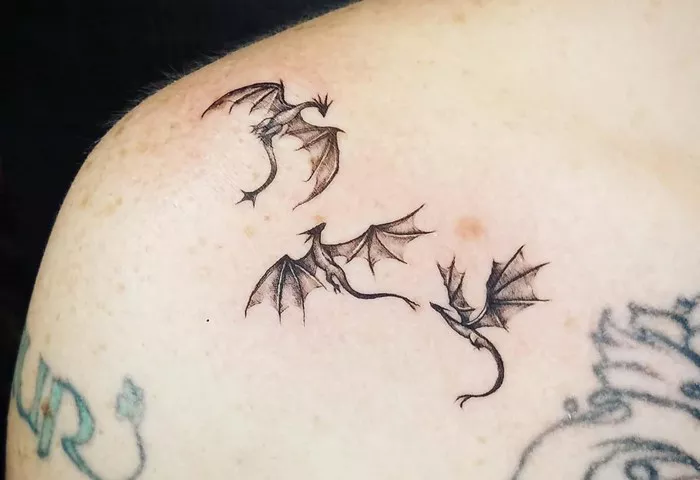The Asian dragon tattoo is more than just an aesthetic choice; it embodies a rich tapestry of cultural significance, symbolism, and history. Revered in various Asian cultures, dragons represent power, wisdom, and good fortune. This article will explore the origins of the Asian dragon tattoo, its evolution through different historical periods, cultural variations, and its contemporary significance. By the end, you’ll have a deeper understanding of when the Asian dragon tattoo was born and how it has become a timeless symbol in body art.
The Origins of the Asian Dragon
Early Depictions in Asian Culture
The concept of the dragon in Asian culture dates back thousands of years. The earliest known representations can be traced to the Neolithic period, around 5000 BCE, where dragon motifs appeared in pottery and jade carvings in regions such as China.
Chinese Dragons: A Symbol of Power
In China, dragons have long been associated with emperors and imperial power. The earliest texts, such as the “Shang Dynasty Oracle Bones” (c. 1600-1046 BCE), reference dragons in the context of royal lineage and divine authority. The dragon became a symbol of sovereignty and was often depicted in art and architecture, reflecting its revered status.
The Influence of Mythology
Chinese Mythology
Chinese mythology has played a crucial role in shaping the symbolism of dragons. The dragon is often seen as a benevolent creature associated with water, rain, and agriculture. Legends such as the “Dragon King” showcase dragons as guardians of water bodies, emphasizing their role in sustaining life and prosperity.
Other Asian Cultures
While the Chinese dragon is the most well-known, other Asian cultures have their own interpretations:
Japanese Dragons: In Japan, dragons are typically depicted as water deities, symbolizing strength and good fortune. The “Yamato” dragon, a mythological creature, is linked to storms and rain, similar to its Chinese counterpart.
Korean Dragons: In Korea, dragons are seen as protectors of the land and people. They are often associated with agriculture and fertility, appearing in traditional art and folklore.
The Evolution of the Asian Dragon Tattoo
Early Tattoo Practices
Tattoos have been part of various cultures for millennia, serving purposes that range from religious to protective. The practice of tattooing in Asia has historical roots that intertwine with the dragon symbol.
Traditional Tattooing Techniques
In ancient times, tattooing methods varied by region. In Japan, the “Irezumi” technique, which involves hand-poking ink into the skin, emerged around the Edo period (1603-1868). This method allowed for intricate designs, making it ideal for representing detailed motifs like dragons.
The Emergence of the Asian Dragon Tattoo
The Asian dragon tattoo gained popularity in the 19th century, particularly in Japan and China. During this time, the rich symbolism of the dragon began to be embraced in tattoo culture, reflecting the broader societal admiration for these mythical creatures.
Japanese Influence
The ukiyo-e art movement in Japan, characterized by woodblock prints, often depicted dragons in various forms. These prints influenced tattoo artists, leading to the rise of dragon tattoos as popular designs in the late 19th century.
Western Adoption
As cultural exchanges increased, particularly during the late 19th and early 20th centuries, Western societies began to adopt Asian dragon tattoos. Sailors, who often traveled to Asia, brought these designs back with them, further popularizing the dragon motif in Western tattoo culture.
Cultural Variations of Asian Dragon Tattoos
Symbolism and Meaning
While the dragon symbolizes power and protection across various cultures, the specifics of its representation can differ significantly:
Chinese Dragon Tattoos: These often feature a long, serpentine body and are adorned with clouds, water, or pearls, symbolizing wisdom and strength.
Japanese Dragon Tattoos: Typically portrayed with three claws, Japanese dragons are often depicted in dynamic poses, reflecting motion and vitality. They may also incorporate elements like cherry blossoms, waves, and koi fish.
Korean Dragon Tattoos: Korean dragons, or “Yong,” are often depicted as benevolent creatures that bring prosperity and harmony. They are usually shown with a more robust body and distinct features compared to their Chinese and Japanese counterparts.
Modern Interpretations
In contemporary tattoo culture, the Asian dragon tattoo has evolved to encompass modern design elements, blending traditional motifs with new styles. Artists now incorporate techniques like watercolor, geometric patterns, and abstract forms, allowing for a more personal interpretation of the dragon’s symbolism.
The Popularity of Asian Dragon Tattoos Today
The Rise of Custom Designs
In the age of customization, many tattoo enthusiasts seek personalized designs that reflect their unique stories. Asian dragon tattoos are often reimagined to align with individual values and experiences. This has led to a surge in the popularity of custom dragon tattoos, incorporating elements that hold personal significance.
Cultural Appreciation vs. Appropriation
As the popularity of Asian dragon tattoos has grown, discussions around cultural appreciation versus cultural appropriation have emerged. It is essential for individuals to approach these designs with respect and understanding of their cultural significance. Engaging with the culture, learning about its symbolism, and seeking out knowledgeable artists can help foster a respectful appreciation.
Conclusion
The Asian dragon tattoo is a powerful emblem of cultural heritage, embodying centuries of symbolism and artistry. Its origins can be traced back to ancient depictions in various Asian cultures, and its evolution over time has cemented its status as a beloved design in the tattoo world. From its early representations in pottery to its modern interpretations in tattoo parlors, the Asian dragon continues to captivate and inspire.
Whether you are drawn to its historical significance, cultural depth, or aesthetic appeal, the Asian dragon tattoo remains a timeless choice for self-expression. As you contemplate this design, remember the rich stories and meanings it carries, ensuring that your tattoo resonates with your personal journey and appreciation for the artistry it represents.
Related topics:

